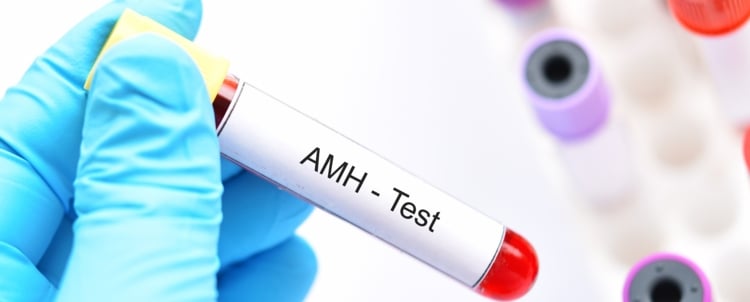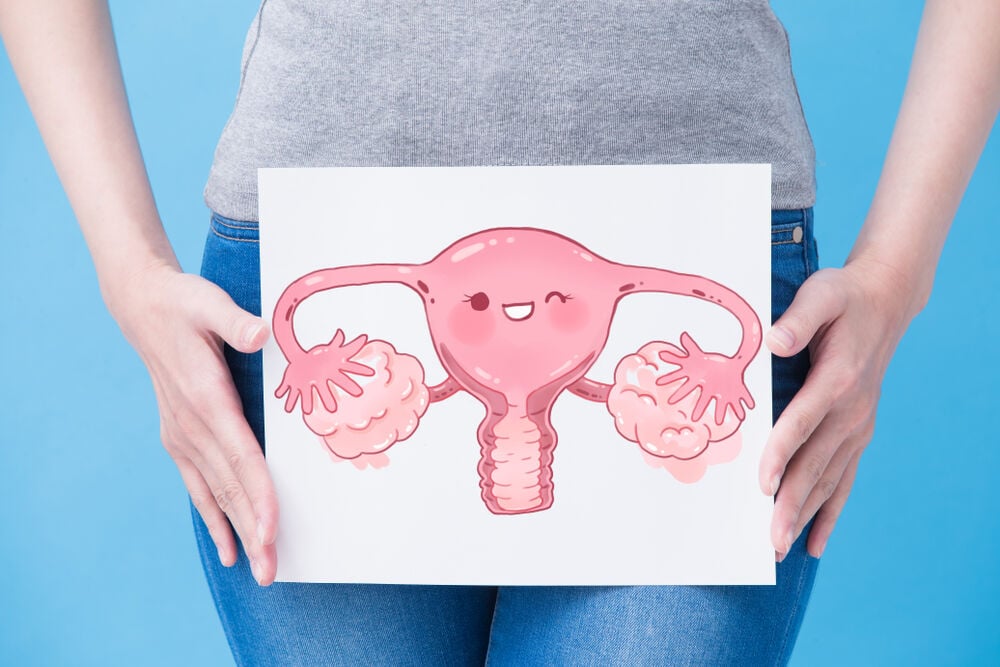The anti-Müllerian hormone test is often given to people receiving treatment for infertility. The test provides answers to a couple of important questions. Let’s learn more about it.
-
Tracking cycle
-
Getting pregnant
-
Pregnancy
-
Help Center
-
Flo for Partners
-
Anonymous Mode
-
Flo app reviews
-
Flo Premium New
-
Secret Chats New
-
Symptom Checker New
-
Your cycle
-
Health 360°
-
Getting pregnant
-
Pregnancy
-
Being a mom
-
LGBTQ+
-
Quizzes
-
Ovulation calculator
-
hCG calculator
-
Pregnancy test calculator
-
Menstrual cycle calculator
-
Period calculator
-
Implantation calculator
-
Pregnancy weeks to months calculator
-
Pregnancy due date calculator
-
IVF and FET due date calculator
-
Due date calculator by ultrasound
-
Medical Affairs
-
Science & Research
-
Pass It On Project New
-
Privacy Portal
-
Press Center
-
Flo Accuracy
-
Careers
-
Contact Us
Anti-Müllerian Hormone Test: 6 Things You Should Know


Every piece of content at Flo Health adheres to the highest editorial standards for language, style, and medical accuracy. To learn what we do to deliver the best health and lifestyle insights to you, check out our content review principles.
What is anti-Müllerian hormone (AMH)?
The anti-Müllerian hormone is produced by granulosa cells of growing follicles (during early stages of their development) in the ovaries. This hormone determines ovarian reserve. In other words, it defines the quantity but not the quality of follicles in the ovaries. It can also be used as a marker for polycystic ovary syndrome (PCOS).
The anti-Müllerian hormone is closely related to issues of fertility and of high importance to those who are trying to conceive. It has been used as an ovarian reserve marker since 2002. The ovarian reserve is also a strong indicator of the pregnancy treatment outcome.
People who are being examined for infertility are likely to have their AMH levels checked.
Regarding treatment for infertility, the anti-Müllerian hormone test provides answers to a couple of important questions:
- What is the ovarian reserve?
- Are there enough eggs for successful in vitro fertilization (IVF), and how will the ovaries respond to stimulation?
- Should egg freezing or planning a pregnancy sooner be considered?

Anti-Müllerian hormone levels
Typically, anti-Müllerian hormone levels increase until early adulthood, peak after puberty, and then slowly decrease with increasing age until becoming undetectable at menopause. This happens about five years before menopause, when there are no growing follicles left.
AMH levels are estimated in nanograms per milliliter (ng/ml). The normal range of AMH depends on age, testing method, and manufacturer. Only a specialist can interpret the results. There is no strictly universal interpretation range, so it’s best to leave the AMH level interpretation to a health care provider for accuracy.
Here are some female AMH-level reference values according to age:
| Age | AMH Level | |||
|---|---|---|---|---|
| 12–14 years | 0.49–6.9 ng/ml | |||
| 15–19 years | 0.62–7.8 ng/ml | |||
| 20–24 years | 1.2–12 ng/ml | |||
| 25–29 years | 0.89–9.9 ng/ml | |||
| 30–34 years | 0.58–8.1 ng/ml | |||
| 35–39 years | 0.15–7.5 ng/ml | |||
| 40–44 years | 0.03–5.5 ng/ml | |||
| 45–50 years | <2.6 ng/ml | |||
| 51–55 years | <0.88 ng/ml | |||
| >55 years | <0.03 ng/ml |
Take a quiz
Find out what you can do with our Health Assistant
Factors that influence AMH levels
There are multiple factors that can contribute to low AMH. Here are some of them:
- Age. AMH naturally decreases with age. There might be a link between fertility and age, as AMH starts decreasing after the age of 35.
- A history of hormonal disorders and medical conditions related to the reproductive system might also affect AMH levels. For example, PCOS often presents with higher levels of AMH.
- A history of ovarian surgery due to endometriosis, ovarian cyst, ovarian torsion, or ectopic pregnancy can also come with a higher risk of low anti-Müllerian hormone levels.
- Stress has one of the biggest negative influences on AMH. People who are living under constant stress and mental pressure often find it hard to conceive until their stress levels reduce.
- Vitamin deficiency, particularly vitamin D, is known to have a connection with fertility issues and AMH levels.
What is an AMH test?
An AMH test is a simple laboratory blood test that measures the hormone levels. It requires about 3 milliliters of blood. Because AMH levels do not change during the menstrual cycle, the test can be performed on any day. Reports usually come back within a couple of hours to a couple of days, depending on where the test is being performed.
There is no special treatment or diet regimen to follow to prepare for the test. However, it can be useful to coordinate other fertility treatments that are related to the day of the menstrual cycle with the AMH test.

Fertility assistance video course
Everything you need to know about fertility assistance in one video course
What do the AMH test results mean?
The normal range of AMH levels varies depending on many factors, including age, testing method, and manufacturer. Only a health care provider can interpret the results for a specific case.
Nevertheless, there are some tendencies in AMH level concentrations.
An elevated AMH level can indicate PCOS. In this case, concentrations may be two to five times higher than normal. This may potentially increase the risk of ovarian hyperstimulation syndrome for those who are planning assisted reproductive treatment.
If a health care provider interprets the AMH level as normal, that means that the ovarian reserve is normal, suggesting other reasons for infertility. If AMH levels are normal and pregnancy still hasn’t been possible, further examination might be necessary. Health care providers may suggest improving overall health with better nutrition, exercise, and more relaxation.
If a health care provider interprets a decreased AMH level, that can indicate a low ovarian reserve. It doesn’t mean that natural conception is impossible, but a health care provider may suggest planning for pregnancy sooner or trying IVF or FSH administration. Low AMH levels also mean that earlier menopause is likely.
If there are no issues with sperm count, a health care provider who discovers that the AMH is normal will advise treatment to remove other health factors that might negatively affect conception. If natural conception is theoretically possible, a health care provider will advise treatments and lifestyle changes to improve the chances of getting pregnant.
How to increase the chances of getting pregnant if AMH level is low
Low AMH basically means a low ovarian reserve, but it doesn’t mean that it’s not possible to conceive naturally.
It’s not possible to increase AMH levels. However, there are other things that health care providers advise that can boost the chances of conception.
Here are a couple things that may be helpful:
Vitamin D supplementation
Studies have shown that women with insufficient vitamin D are more likely to have low AMH. There are lots of different ways to increase vitamin D intake, such as with supplements or diet. A blood test is the most reliable way to measure vitamin D levels.

L-arginine supplementation
L-arginine supplementation is known to improve ovarian function. To make a difference with ovarian functioning, 4 to 5 milligrams per day of this supplement are necessary.
Stress reduction
Getting enough rest and managing stress are both important parts of improving the chances of conception. Allowing for rest, taking good care of yourself, practicing yoga, and anything else that keeps stress under control may help improve the chances of getting pregnant.
Summing up
Knowing anti-Müllerian hormone levels along with other tests and examination results can help determine the best type of infertility treatment. It allows health care providers to tailor treatments for optimal results.
This can help parents-to-be achieve pregnancy faster than they normally would.


Hey, I'm Anique
I started using Flo app to track my period and ovulation because we wanted to have a baby.


The Flo app helped me learn about my body and spot ovulation signs during our conception journey.


I vividly
remember the day
that we switched
Flo into
Pregnancy Mode — it was
such a special
moment.
Real stories, real results
Learn how the Flo app became an amazing cheerleader for us on our conception journey.
References
Mumford, Sunni L et al. “Baseline AMH Level Associated With Ovulation Following Ovulation Induction in Women With Polycystic Ovary Syndrome.” The Journal of clinical endocrinology and metabolism vol. 101,9 (2016): 3288-96. doi:10.1210/jc.2016-1340 https://www.ncbi.nlm.nih.gov/pmc/articles/PMC5010565/
Kissell, K A et al. “Biological variability in serum anti-Müllerian hormone throughout the menstrual cycle in ovulatory and sporadic anovulatory cycles in eumenorrheic women.” Human reproduction (Oxford, England) vol. 29,8 (2014): 1764-72. doi:10.1093/humrep/deu142
https://www.ncbi.nlm.nih.gov/pmc/articles/PMC4093994/
“Anti-Müllerian Hormone Test: MedlinePlus Medical Test.” MedlinePlus, U.S. National Library of Medicine, 15 Dec. 2020, medlineplus.gov/lab-tests/anti-mullerian-hormone-test/.
“Test ID: AMH1 – Antimullerian Hormone, Serum.” AMH1 - Clinical: Antimullerian Hormone, Serum, www.mayocliniclabs.com/test-catalog/Clinical+and+Interpretive/608824.




